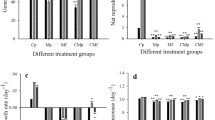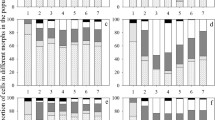Three aspects of size selective feeding by the scuticociliate Cyclidium glaucoma were studied in continuous cultivation systems. Firstly, grazing-induced changes in abundance, biomass, and size structure of a bacterial community were investigated. Secondly, we studied possible grazing-protection mechanisms of bacteria as a response to permanent presence of the predator. And finally, we were looking for potential feedback mechanisms within this predator-prey relationship, i.e., how the ciliate population reacted to a changed, more grazing-protected bacterial community. The first stage of the cultivation system consisted of the alga Cryptomonas sp. and the accompanying mixed bacterial community. These organisms were transferred to two second stage vessels, a control stage without ciliates and a second one inoculated with C. glaucoma. After the first week, the abundance of bacteria in the latter decreased by 60% and remained stable until the end of the experiment (65 d), whereas bacterial biomass was less affected (393 mg C L-1 during days 0-7, 281 mg C L-1 afterwards). The mean bacterial cell volume doubled from 0.089 mm3 to 0.167 mm3, which was mainly due to increasing cell widths. During the whole investigation period formation of colonies or filaments was not observed, but we found a clear feedback of ciliates on bacterial size. An increase in bacterial cell volume was always followed by a decline of the predator population, resulting in a yet undescribed type of microbial predator-prey relation. Literature and our own data on the optimal food size range grazed by C. glaucoma showed that bacterial cell width rather than length was responsible for that observed phenomenon. Finally, we suggest that uptake rates of spherical latex beads give only limited information on truly ingestible prey volumes and that prey geometry should be considered in future studies on size selective feeding of protists.
Similar content being viewed by others
Author information
Authors and Affiliations
Rights and permissions
About this article
Cite this article
Posch, T., Jezbera, J., Vrba, J. et al. Size Selective Feeding in Cyclidium glaucoma (Ciliophora, Scuticociliatida) and Its Effects on Bacterial Community Structure: A Study from a Continuous Cultivation System. Microb Ecol 42, 217–227 (2001). https://doi.org/10.1007/s002480000114
Received:
Accepted:
Issue Date:
DOI: https://doi.org/10.1007/s002480000114




